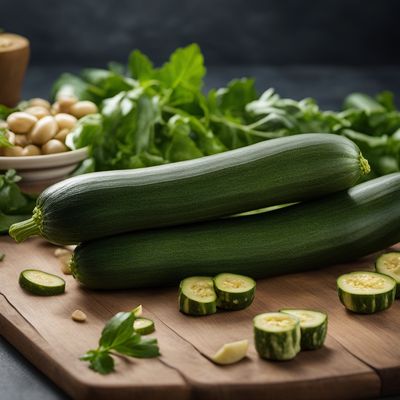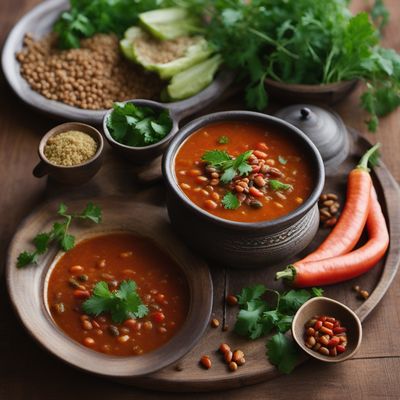
Ingredient
Bottle gourds
The Versatile Gourd: Unveiling the Secrets of Bottle Gourds
Bottle gourds are elongated, green-skinned vegetables with a mild, slightly sweet flavor and a crisp, watery texture. They have a cylindrical shape, resembling a bottle, hence the name. The flesh of bottle gourds is white and spongy, with a seed-filled central cavity. When cooked, they become tender and absorb the flavors of the dish, making them a popular choice in various cuisines around the world.
Origins and history
Bottle gourds have a long history, dating back thousands of years. They are believed to have originated in Africa and have been cultivated in Asia, Europe, and the Americas for centuries. In many cultures, bottle gourds hold symbolic and spiritual significance, often associated with fertility, abundance, and good luck. They have been used for culinary purposes, as well as for making utensils, musical instruments, and decorative items.
Nutritional information
Bottle gourds are low in calories and rich in essential nutrients such as vitamin C, vitamin B6, potassium, and fiber, making them a healthy addition to any diet.
Allergens
Bottle gourds are generally considered safe and do not pose significant allergenic risks. However, individuals with known allergies to cucumbers or melons should exercise caution, as bottle gourds belong to the same family.
How to select
When selecting bottle gourds, look for ones that are firm, heavy for their size, and have smooth, unblemished skin. Avoid gourds with soft spots, mold, or signs of decay. The stem should be intact and green. Smaller bottle gourds tend to be more tender and flavorful.
Storage recommendations
To maintain the freshness of bottle gourds, store them in a cool, dry place away from direct sunlight. They can be kept at room temperature for up to a week. If cut, wrap the remaining portion tightly in plastic wrap or store in an airtight container in the refrigerator for up to 3 days.
How to produce
Bottle gourds can be grown by amateur gardeners in warm climates. They require well-drained soil, ample sunlight, and regular watering. Start by planting seeds or seedlings in a prepared garden bed or container. Provide support for the vines to climb, as bottle gourds are vigorous climbers. Harvest the gourds when they reach the desired size and have a firm texture.
Preparation tips
Bottle gourds can be used in a variety of dishes, including soups, stews, curries, stir-fries, and even desserts. To prepare, peel the skin using a vegetable peeler or knife, remove the seeds, and cut into desired shapes. They can be cooked by boiling, steaming, sautéing, or baking. Bottle gourds pair well with spices, herbs, and other vegetables, absorbing flavors beautifully. To retain their crisp texture, avoid overcooking.
Substitutions
If bottle gourds are not available, zucchini or summer squash can be used as suitable substitutes due to their similar mild flavor and texture.
Culinary uses
Bottle gourds are widely used in various cuisines around the world. They are commonly used in Indian, Chinese, and Southeast Asian dishes, such as Lauki ki Sabzi (Indian bottle gourd curry), Chinese stir-fried bottle gourd, and Thai bottle gourd soup. They can also be grated and used in desserts like bottle gourd halwa or added to smoothies for a refreshing twist.
Availability
Bottle gourds are commonly available and cultivated in many regions, including Asia, Africa, Europe, and the Americas.
More ingredients from this category

Pointed gourds
The Elegant Delicacy: Pointed Gourds

Courgettes
The Versatile Zucchini

Ivy gourds
The Versatile Ivy Gourd: A Hidden Gem in the Culinary World

Summer squashes
Versatile Delights of Summer

Angled luffas
The Versatile Vegetable: Angled Luffas

Sopropos
The Versatile Gourd

Snake gourds
Serpentine Delights

Chayote fruits
The Versatile Chayote: A Hidden Gem in the Culinary World
Recipes using Bottle gourds

Mướp xào trứng with a Twist
Savory Stir-Fried Bottle Gourd with Eggs

Handvo - Savory Lentil Cake
Spiced Lentil Delight: Handvo - A Flavorful Indian Lentil Cake

Kenyan Coconut Lime Gourd Soup
Tropical Delight: Kenyan Coconut Lime Gourd Soup

Gursan - Kashmiri Style Meat and Vegetable Stew
Kashmiri Gursan: A Hearty Blend of Meat and Vegetables

Khar - Assam's Traditional Delight
Smoky and Spicy Assamese Khar: A Culinary Adventure from Northeast India

Indonesian Spiced Coconut and Lime Gourd Soup
Savor the Exotic Flavors of Indonesian Spiced Coconut and Lime Gourd Soup

Balochi-style Vegetable Soup
Savory Delight: Balochi Vegetable Soup with a Twist